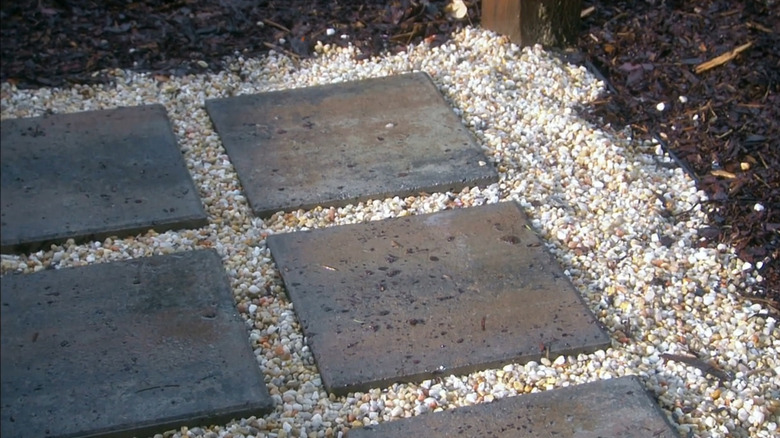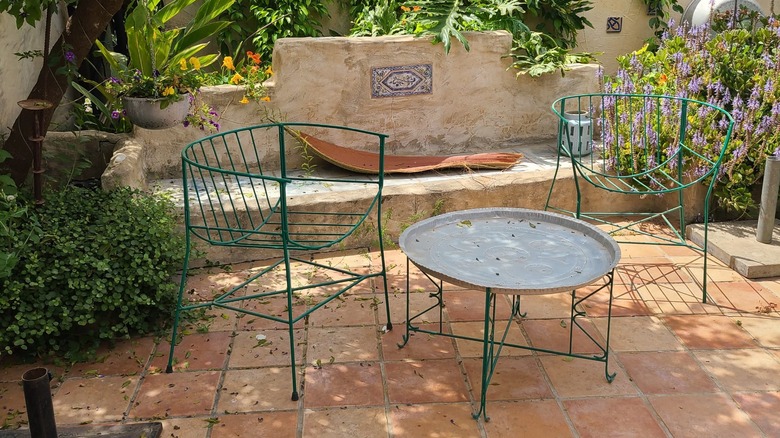Our Design Expert Has Some Thoughts About Hilary Farr's Dramatic Backyard
HGTV's Hilary Farr is an expert at flipping unusable, messy spaces into areas a family can't wait to gather in. Whether those are cramped living rooms, dysfunctional kitchens, or overgrown backyards, her redesigns help transform these troublesome spots into liveable spaces. In a Season 12 episode of "Love It or List It," Farr does just that for a family's muddy backyard. Called "Teenage Wasteland," the episode centers on homeowners Anna Wade and Andrew, who feel like their home has become too cramped after their two kids have grown into teenagers.
There aren't enough spots to stretch out in their home, so Farr is tasked with carving out more leisure room. One way she does this is to transform their muddy backyard into a tidy area with a porch swing, and she gets the mud under control by using pavers and gravel. But is that the best idea? We asked a landscaping expert to find out.
As it turns out, using gravel is helpful to control a messy section of the yard, but it might not be the best idea in a high-traffic area, such as a back patio. "In general this is not a bad design, but longevity and practicality are compromised," Roy Altaras, owner of Roy Altaras Landscape Design and Build, exclusively tells House Digest. "In my opinion, a design like this is better off in a corner of a property when used as a secondary seating area and not as the main patio." Here's a closer look into why.
Benefits of creating a paver and gravel patio
In the "Love It or List It" episode, Hilary Farr designs a back patio using square concrete pavers sitting on top of white gravel. These are two of the most affordable materials to create a beautiful backyard patio; they're more cost-effective than investing in stone or tiles. "Clearly, the pros of this design are the relatively low costs and ease of installation," Roy Altaras exclusively tells House Digest. "Standard concrete pavers are affordable and can be found in most construction shops/garden centers; the same goes for gravel." A beginner can also likely install this in an afternoon since there isn't much to it other than leveling the area and arranging the stones.
There are also some foundational advantages to using these materials in particular. "Another benefit is the permeability of the surface, allowing storm water to penetrate and prevent runoff. This is one reason for using gravel in between, other than its aesthetics," Altaras explains. Rather than pooling on the surface, the water will soak into the ground. This will also keep a mud-prone area dry since your feet can land on the pavers rather than the bare ground. However, the design can really limit how you use the space.
Drawbacks of using pavers and gravel in high-traffic areas
A more permanent design would better benefit you in the long run. "The drawbacks of such design, however, are the day to day practicality; placing a table and chairs can get tricky because the legs may fall in between the pavers and sink in the gravel," Roy Altaras exclusively tells House Digest. Instead, it's better to place stationary furniture here, which you don't have to move around, such as a porch swing or a permanent bench.
It can also be harder to clean, which might make the design cumbersome after a while. For instance, if you have a tree nearby and the patio accumulates leaves, they won't be simple to rake up. "One would need a little battery operated blower, and hosing it down may require some extra skill in order to keep the gravel in place," Altaras points out. Cleaning a patio with larger slabs and drains is much easier.
Instead, he recommends building a stone patio. "It is a natural and durable option that adds warmth and character to any space; it is timeless," he shares. However, if stone doesn't match the aesthetic of your house, you can also use tiles or concrete for similar benefits. Do you like the price of concrete but worry it won't give your backyard a wow factor? "Concrete does not have to be grey and dull; it can be textured in different finishes, stained, sealed, and patterns can be engraved in it," Altaras explains.


